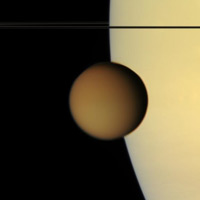 Julie Webster,
Julie Webster,
Spacecraft Operations Team Manager, NASA’s Cassini spacecraft
On Sunday evening, my eyes were glued to eight windows on my computer screen, watching data pop up every few seconds. NASA’s Cassini spacecraft was making its lowest swing through the atmosphere of Saturn’s moon Titan and I was on the edge of my seat. Trina Ray, a Titan orbiter science team co-chair, was keeping me company. Five other members of my team were also at JPL. Between us, we were keeping an eye on about 2,000 data channels.
One of the 34-meter antennas at the Deep Space Network’s Goldstone complex, DSS-24, was pointed at Saturn and listening for the signal that was expected to be here in just a few minutes. The data would be arriving at my computer as quickly as they could be sent back to Earth, though there was an agonizing hour-and-18-minute delay because of the distance the data had to travel. (We call this flyby T70, but it is actually Cassini’s 71st flyby of Titan.)
It was a nervous time for me — the previous night we had been at JPL to send some other real-time commands to the spacecraft when an alarm came in indicating that the magnetometer, the prime instrument taking data for the T70 flyby, needed a reset. Fortunately, the controller on duty immediately called the magnetometer instrument operations team lead in England. Within 90 minutes, the commands were on their way to do a computer reset and clear the alarm. At 2 a.m. Pacific time on Sunday, we got the email indicating all was well and the magnetometer was ready for the Titan closest approach.
So here we were, past one hurdle, hoping nothing else would come up. We had run hundreds of simulations over the past three-and-a-half years, so I knew we had done everything we could think to do. We did more training for this event than anything else we had done since we dropped off the Huygens probe in January 2005 for a descent through the moon’s hazy atmosphere.
Right on time, at 7:26 p.m., the Deep Space Network locked on the spacecraft downlink, a good start. I was focused on the data for spacecraft pointing. As long as we stayed within an eighth of a degree of the expected pointing, everything would be fine. At 7:45 p.m., we got the data from closest approach, a mere 880 kilometers (547 miles) in altitude. Over the vocabox, a cross between a telephone and walkie-talkie, the attitude control team reported that the thrusters were firing about twice as much as we expected. The Titan atmosphere appeared to be a little thicker than we expected, even though we had fed about 40 previous low Titan flybys by Cassini and the descent data from Huygens into our modeling.
But spacecraft control was right on the money, keeping the pointing within our predicted limits. Even with the extra thrusting, we stayed well within our safety margin.
At 7:53 p.m., the spacecraft turned away to go to the next observation. I let out a sigh of relief, happy that everything during closest approach had gone just as we planned. Five attitude control guys crowded into my office with smiles on their faces. Trina and I were marveling at what a wonderful spacecraft we have to work with. Another first for the Cassini mission!
Now, as Trina says, we have to finish the job by returning all the great science data. We have data playbacks today at two different Deep Space Network stations to make sure we have – as we say here – both belts and suspenders. Engineers will also go back to analyze the data with the scientists to see just how dense the Titan atmosphere turned out to be at our flyby altitude.
But last night, at least, my team and I went home happy!
Julie Webster, spacecraft operations team manager for NASA’s Cassini spacecraft, oversees the engineering subsystems and overall spacecraft health and safety. She is a systems engineer at JPL.

 Cesar Bertucci,
Cesar Bertucci,